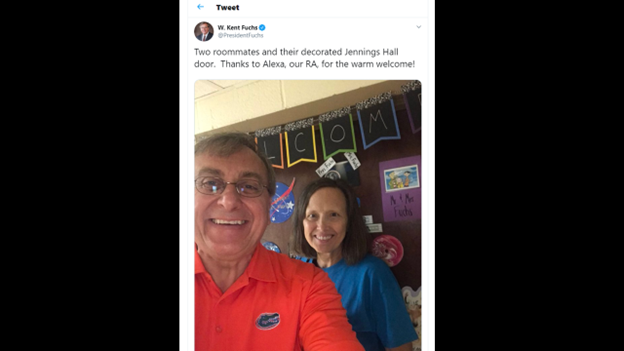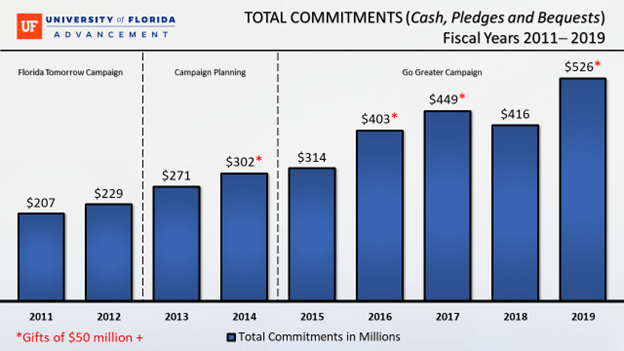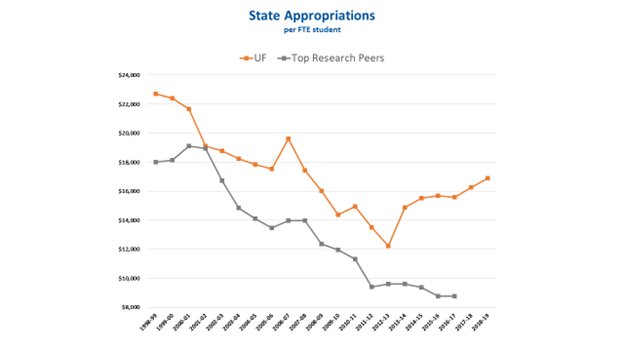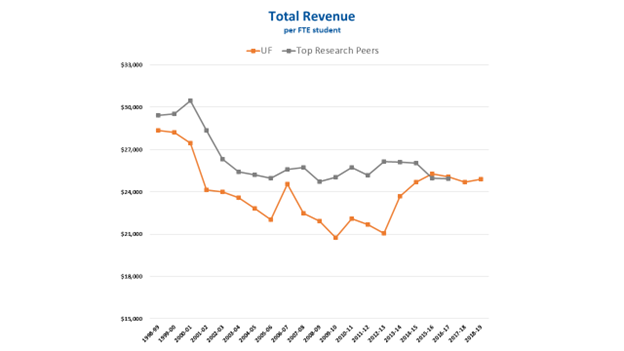 Statements
Statements
I hope your summer was restful and productive, and this week’s start of the new academic year has brought you not only new students and new colleagues, but also new opportunities and a renewed energy and enthusiasm for your work.
When I think of what each of us needs to accomplish this year, this fall, and even this month, it is daunting and even a little discouraging. However, that is balanced with the reminder of the privilege we each have to work at a university where we all are contributing to making a difference in the lives of students and in the lives of people around the world.
Let me begin with the past few days, and all the students, both new and returning, that have now arrived and have started classes.
Last week Linda and I helped new students move into the residence halls and we joined them by also moving into Jennings Residence Hall. The students at Jennings were very happy to welcome us as we moved in and even happier when we moved out with the start of classes!

Monday morning we had a particularly notable convocation ceremony when 6,522 freshmen filled Exactech Arena for Convocation. Professor Ted Spiker gave an outstanding address, welcoming and challenging our new first-year students with his “Top 10 Tips for Success.”
Our new students this fall come from 106 countries; Guam, Puerto Rico, and the U.S. Virgin Islands; and all 50 states.
A typical state of the university address focuses on the accomplishments of the past year and describes some of the challenges and opportunities for the new year. Last year at this time we were celebrating our first time ever ranking as a top-10 public research university, tied at #9. We didn’t know it then, but a few weeks later UF would move up to #8. In last year’s state of the university address, I challenged us to think about what is next for UF, beyond Top 10?
In the past year, we have determined that our new goal for UF is that we will be a top-5 Public Research University. Our alumni and supporters know that our goal is to be Top 5 and even our new students and families know our goal.
This afternoon, I would like to ask that we not reflect on the accomplishments of only the past year nor the opportunities for only the coming year.
Instead, I am going to ask you to reflect with me on the past five years and also think and dream about what we might accomplish in the next five years.
How might UF be different in 5 years? Certainly, our goal now is that we will be ranked in the Top 5 and every college and academic department will also move up in stature, ranking, impact, and visibility.
I’m going to ask you six questions to prompt your thinking about five years from now. As I ask these questions, I expect you will soon get my point.
I expect you quickly got my point as I went through my six questions.
All the changes in the metrics I asked about possibly occurring over the next five years did occur in the past five years.

The changes to these metrics are significant and dramatic. I am not sure I would have had the optimism or faith five years ago to predict these changes, yet they did occur.
My point is not that the exact same change is going to occur in the next 5 years, but I am absolutely convinced that the opportunities today, across our university, are even greater than they were five years ago.
Thus, I ask all of us to do two things: 1) dream big, and have great aspirations for the next five years, and 2) seize the opportunities that are before us. Momentum is building at UF, and we should add to that momentum, not rest or grow complacent.
If there is a moment to extend our gains of the past five years to shape even more remarkable gains, and to rise to the pinnacle of U.S. public universities, now is that moment.
Let me provide a sense of the opportunity before us.
The future of our university is inextricably linked to the future of our State of Florida. In other words, not only are we more dependent on the State of Florida, than our peers and competitors, but I also believe we have the capacity, more than other universities, to influence the future of our state.
The State of Florida is the third-most populous in the country and growing by 1,000 residents a day. We’re an incredibly diverse state and we’re a bellwether for the nation. We’re first on the nation’s list for vacation, retirement and, increasingly, for healthcare.
The State of Florida has the opportunity to make a transition from popularity to preeminence – in other words, to establish a new identity not just as a destination state but as an economic powerhouse and a leader in societal solutions to challenges facing our nation.
This requires our state to seize the important opportunities before us.
I believe our state has an opportunity to become:
How can our State of Florida do all this? UF is the key. UF can and will provide the leadership and partnership with our state in seizing these opportunities.
With our stature as a top research institution, our tradition of comprehensive excellence and robust presence in every corner and county of the state, we will lead the state, and our state will be the national leader in the areas that are important for our nation and the world’s future.
In the past five years, UF has demonstrated unparalleled return on investment, as reflected across the university.
I’m absolutely certain that the next five years will be even brighter and even more will be accomplished than the past five.
I also know there are challenges. The obstacles we face are formidable and numerous, but again, there were also many challenges just as formidable five years ago.
Without dampening my optimism for the next five years, let me share two challenges that are particularly on my mind, for which I need your help.
We reached this place in the history of our university due to the strength of many years of focused effort by our exceptional faculty, staff, and students and the generous support of alumni, friends and elected officials.
As much commitment as was required to get here, our path forward is even steeper, as we ask everyone to double down and seize the opportunities of the next five years. Let me give two examples:
First example: philanthropy

The progress in the philanthropy of our alumni and friends has been dramatic. However, it has taken incredible generosity and effort to get to this point and the real risk is that we will accept where we are today as “good enough”. How could we possibly work harder to continue to make progress like this over the next five years and how could our friends and alumni possibly be even more generous? I suggest, that we must and we will, double down on philanthropy to UF. We exceeded our dreams and aspirations from five years ago, and we must do the same for the next five years.
My second example is investment by the State of Florida.
We know we must invest in faculty, staff, and infrastructure. This will require that our state, over the next five to ten years, make significant new and greater investments in UF– meaningfully adding to its investments of the past five years, for which we have demonstrated a dramatic return.

This slide shows the investment in UF per FTE student compared to our top public research university peers. As you can see, the State does invest in UF more than other states invest in their leading research universities, particularly in the past five years. However, let me show you the sum of the state investment and tuition, per student.

This is the important metric, since UF has tuition and fees for in-state students that are dramatically lower than any of our public peers.
This slide has several messages. First, we have made progress in drawing close to our top public research university peers in this combination of tuition and state investment. However, although we are above where we were after the great recession, we are still below where we were at the turn of the century. Also, know that the states with whom we compete have begun to make a reinvestment, so we believe we lost ground this past year.
Let me be specific. This year, our tuition and fees have again not increased, and for the first time in several years, our net state appropriation did not increase. The state legislature and governor were actually very generous in directing significant new resources to UF. However, the funding that flows through the State University System declined significantly, due primarily to the way funds are distributed across the system. We were ranked number one in the SUS metrics and total score; however, funds were reallocated to the lowest-ranked universities this year. While I understand the intention of the Florida Board of Governors, the net result is that we did not have an increase in our total state funding nor tuition and fees.
However, the investment the university is making is increasing this year. The 3% pool for compensation increases we previously announced represents an additional $27M in annual expenditures of state funds. Faculty promotions this year will cost an additional $1.5M in annual state funds. The change in minimum wage affecting our lowest-paid TEAMs employees will require $1M/year in state funds and finally, our growth in faculty for this year, the completion of the faculty 500 initiative, will cost an additional $15M per year.
In summary, this fiscal year we have made commitments for an additional $44.5M in state and tuition expenditures, on a recurring basis. We have been able to develop short-term solutions to make this possible, with the expectation that we will receive next year the additional funding we have committed.
Remember, our aspirations are not just to balance our budget, but we have aspirations to achieve top-5 status, which will require us to have the number and quality of faculty and staff of a top-5 public research university and to compensate them at the level of a top-5 public research university. We must have a top-5 student to faculty ratio and we must have not just a growth in faculty, but also a growth in critical staff, those that support our students and faculty and make our programs successful. We must have the infrastructure and facilities of a top-5 university. This is daunting, but I truly believe we will achieve that goal, particularly given what has been achieved in the past five years.
Now, the second and final challenge. In the previous two State of the University addresses, I described a decline in “internationalization” as an external challenge to UF. In particular, I expressed my concern that the number of international students applying to UF, undergraduate and graduate, had declined for both years.
This year, I am pleased to say, the numbers appear to be slightly up.
However, I am including again internationalization as a challenge -- this time cast within the context of pursuing two seemingly conflicting objectives of collaboration and competition.
If we are to be one of the world’s great research universities, as we are, our research and our education must have meaningful connections to every group, every people, every culture across our planet. It is imperative that we remain committed to making sure every international student, every international applicant, and every potential applicant know that UF is a place that welcomes students from all nations and cultures and ethnicities. We must work harder at being an inclusive university for our current and our potential students, as well as visiting staff and faculty from across the globe.
The shifting international landscape requires even more effort on our part and we must be even more intentional about recruiting and supporting international students and colleagues. Our nation has a valued history of being the destination of choice for students from around the world. There is a real risk that may not continue, and we at UF must work to change that trend.
This need for collaboration stands equal, side by side with the reality that we are also competing with the very institutions and nations with whom we collaborate. We compete for students, for talent, for research discoveries, for technology, and for intellectual property rights. We do this as an institution, as a state, and as a nation.
This dichotomy is seen most clearly when we consider the nation of China. In the past ten years, there has been a dramatic change in the position of China, compared to all other nations, including the US, in research and development, particularly in areas of science and engineering.